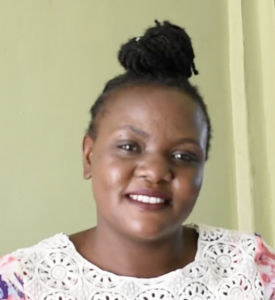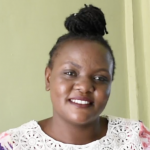The Khaunga Health Center is located at the border of two sub-counties, making it a busy clinic that serves 170 outpatients and ten inpatients on average a day. The dedicated staff of 19 people does their best to meet a variety of needs, but without a reliable, safe water source, proper medical care is nearly impossible.
"Khaunga Health Center is in dire need for water. The facility has a maternity wing, which requires a lot of water. Sometimes, the nurses request the caregivers of the patients to carry 20 liters of water for the patient upon admission," shared Field Officer Adelaide Nasimuyu.

Patients waiting for care.
The staff relies on a few water sources, but none offer consistent water. They have a dug well, but the water is not fit for human consumption, so any water collected is used for tasks like cleaning. It historically runs out of water each year during the dry season.
"Mostly in the dry season, we don't have water. The water in the rain tank dries up, and the water from the well dries up. It is [in] the dry seasons that cause [a] lack [of] water in this facility," shared 38-year-old Doctor Robert Simiyu.

Staff collecting water from the dug well.
Their only other option is rainwater that can be collected in tanks, but those run out of water quickly, too, leaving staff without what they need to do, even the most basic of care, and no water for them or their patients to drink.
"The storage tank has a small capacity that does not last for long. The dug well is also seasonal. It dries up during [the] dry season. This has led the facility to depend so much on water from unknown sources. This is very expensive because you have to pay a motorbike guy to bring water to the health center," Adelaide continued.

Dr. Simuyu at the rainwater tank.
When all the water is gone, the only alternative is to rely on water brought to the center from unknown sources. This puts everyone's health at risk and costs the clinic the valuable resources it needs.
"The water brought [to] the facility from unknown sources is not for us or the patients to drink," said Dr. Simiyu.

Dr. Simuyu.
"Water is life because it [is] very important in our daily hygiene. Without water, the environment that we stay in would be pathetic. We drink water to be healthy. Without water, our bodies wouldn't function well. Drinking water that harms us is not good because treating water-related diseases is very expensive. It is good to take precautions by drinking safe water," he continued.
"The proposed water solution will enable the facility [to] have water throughout the year. The facility will be able to carry out its activities with no worry of where the water will come from. The facility will be able to admit more patients at the health center. The facility has plans of constructing new wards to increase the number of patients that are being admitted on [a] daily basis. They also have plans to build a structure that can be able to accommodate TB patients," concluded Adelaide.
Steps Toward a Solution
Our technical experts worked with the local community to identify the most effective solution to their water crisis. They decided to drill a borehole well, construct a platform for the well, and attach a hand pump.
Well
Abundant water often lies just beneath our feet. Aquifers—natural underground rivers—flow through layers of sediment and rock, offering a constant supply of safe water. A borehole well is drilled deep into the earth to access this naturally filtered and protected water. We penetrate meters, sometimes even hundreds of meters, of soil, silt, rock, and more to reach the water underground. Once found, we construct a platform for the well and attach a hand pump. The community gains a safe, enclosed water source capable of providing approximately five gallons of water per minute. Learn more here!
Handwashing Stations
Alongside each water source, we install gravity-fed handwashing stations at points of care and at the latrines, enabling everyone at the health center to wash their hands. Handwashing is crucial for preventing water-related illnesses within the health center and community. Health center staff will maintain the stations, fill them with water, and supply them with soap, which we will teach them how to make.
Latrines
We ensure there are Ventilated Improved Pit (VIP) latrine blocks that effectively prevent the transmission of fecal diseases. Each latrine will boast a durable cement floor for easy use and maintenance. We’ll ensure at least one stall is reserved for staff, along with gender-separated toilets that include menstrual hygiene facilities.
Health Center Education & Ownership
Hygiene and sanitation training are integral to our water projects. Training is tailored to each health center's specific needs and includes key topics such as proper water handling, improved hygiene practices, disease transmission prevention, and care of the new water point. Encouraged and supported by the guidance of our team, a water user committee comprises a community health volunteer, the staff in charge of the clinic, a community leader, and the health center board representative. They assume responsibility for maintaining the waterpoint, promoting safe hygiene and sanitation practices, and keeping handwashing stations well-stocked.
Safe water and improved hygiene habits foster a healthier future for everyone in the community.

 Borehole Well and Hand Pump
Borehole Well and Hand Pump
 Rehabilitation Project
Rehabilitation Project





























